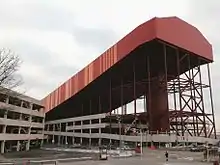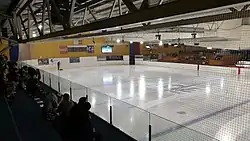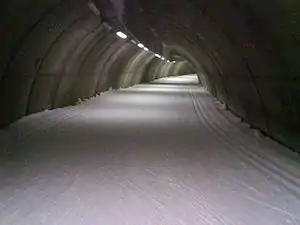Indoor skiing
Indoor skiing is done in a climate-controlled environment with snowmaking. This enables skiing and snowboarding to take place regardless of outdoor temperatures. Facilities for both alpine skiing and nordic skiing are available.

History
Since the early 20th century, there have been four major stages in the evolution of indoor snow centres.
Firstly, centres that had no refrigeration and used an artificial mixture of materials to create a surface substance something like snow, the first of these opened in Austria and Germany in the 1920s. The first recorded indoor snow slope was created at Berlin’s Automobilhalle in the summer of 1926 gaining worldwide attention. According to contemporary reports a wooden slope was created about a thousand feet long and sixty feet wide.
The “snow” substitute used was invented and later patented[1] by a British diplomat, L. C. Ayscough, and involved a mixture of powdered mica, soda crystals and sawdust spread on a brush matting surface. The Berlin government were concerned about health risks from the mixture and commissioned the then head of its Municipal Health Bureau, Dr. Wilhelm von Drigalkski, to check it was safe for public use. He confirmed that it was and an order for 200 tons of the material to be delivered by train was placed.
The slope was initially popular and a company was founded to build more slopes in Dresden, Munich, and Frankfurt. It is not known if these were ever created.
A second indoor centre using "Ayscough snow", planned to be a more permanent facility, opened in Austria the following year later, 1927. Known as Schneepalast (German: Snow Palace), it was opened in the Austrian capital Vienna in 1927 in the abandoned Vienna Northwest Railway Station established by the Norwegian ski jumper Dagfinn Carlsen.[2][3] The track in the 3,000-square-metre (32,000 sq ft) ski area was built on a wooden ramp. A ski jump made it possible to jump up to 20 metres (66 ft). Skiers had to walk up the artificial mountain, because there was no ski lift.[4] However, sledges could be pulled up with an electrically-operated system. The artificial snow had been made by the English experimenter James Ayscough from soda.
After the initial excitement enthusiasm for "Ayscough snow" rapidly waned however as users decided it was not particularly slippery and the initial whiteness rapidly discoloured. The Vienna facility closed in May 1928.[5]
The second attempt at indoor snow centres came three decades later with the first centre that used real snow or crushed ice which was transported inside to a slope covered by a roof and open to urban skiers during cold months of the year in the city of Sayama, Japan.[5] This centre opened in 1959 and continues to operate, although now with on-site snowmaking rather than bringing in snow by lorry.
Thirdly came the first generation of refrigerated indoor centres which used either a chemical mixture to simulate snow or scraped ice. The first three of these opened in 1988, each claiming to be the first in the world. These were MtTheBarton in Adelaide, Australia, Casablanca in Belgium,[6] and Ski in Tsudanuma in Japan.[7]

The fourth and current stage of indoor snow centre development came when centres which used ‘real snow’, made by snow-making machines, with no chemical additives, began to appear. These are now the norm for most of the 140 centres that have been built since the first. which was The Snowdome at Tamworth in the UK which opened in May 1994.[8]
Present Day
Since the first indoor snow centre was built in Berlin in 1926, 149 indoor snow centres have been, most of them since 1990. 113 are currently operational in 35 countries on 6 continents.[9]
Most offer skiing and snowboarding but some, primarily in sub-tropical areas in southeast Asia that do not normally see natural snowfall, exist as snow experience centres offering activities like sledging, snowman building and snowball fights.[10]
The number of centres being built continues to grow and 2019 saw more indoor snow centres open worldwide than any other year. Analysis of the last three decades of indoor snow centre construction saw 2010-19 had the most indoor snow centres built (60), up from 43 between 2000 and 2009 and 34 built in the 1990s.[9]
Asia (especially China) saw the most-new indoor snow centres built since 2010, as it did in the 1990s (back then most were built in Japan). Between those two decades Europe built the most facilities in the first decade of this century. The past decade saw the first indoor snow centres open in Africa (Egypt), North America (USA) and South America (Brazil).[9]
Three of the five-biggest indoor snow centres in the world, including two with 50,000sqm+ (500,000+ square feet) indoor snow space, opened in a 12 month period from March 2019 to March 2020.[9]
Many of the indoor snow centres built in recent years are in China which has 34 centres, more than three times the next closest country (The Netherlands, with seven). China’s SUNAC group has become the world’s largest operator of indoor snow centres, operating seven centres, including the world’s three largest. Two more are under construction, most of these opened in 2019-20.[9]
List of Alpine ski halls by country
- Mt Thebarton Snow and Ice, Adelaide. Operated 1987 - 2005. Built in a state without any ski resorts, it was probably the world's first indoor ski slope on artificial snow.[11]
- Swiss Pavilion at World Expo 88, Brisbane. Two lifts operated for six months. Included a ski slope on artificial snow serviced by a handle tow and a double chairlift operating on a rectangular route.[12][13]
- Snow Valley, Peer http://www.snowvalley.be
- Ice Mountain, Comines
- Harbin Wanda Indoor Ski and Winter Sports Resort located in Harbin, Heilongjiang, world's largest indoor ski resort with 72,600 m2 (17.9 acres; 781,000 sq ft) of indoor snow.[14]
- Yinqixing indoor skiing, Shanghai
- Sunac Snow Park, Guangzhou
- Sunac Snow Park, Wuxi
- Sunac Snow Park, Kunming
- Sunac Snow Park, Chengdu
- Sunac Snow Park, Chongqing
- SnowHall, SnowHall Amnéville, France
- alpinCenter Bottrop in the SnowFunPark in Wittenburg with a 640-metre (2,100 ft) slope and a 31 percent grade.
- SnowDome Bispingen, Bispingen.
- Alpenpark Neuss, 300m slope.
- Trans Snow World in Bekasi, first of a series of snow parks that are opening across Indonesia, which includes also a ski slope and ski lifts. It is possible to ski and learn skiing by Ski Club Indonesia, first Ski operator and association in Indonesia
- Sayama ski resort, Tokorozawa
- SnowWorld, Landgraaf with a total of 35,000 square metres (8.6 acres; 380,000 sq ft) of snow. In 2003, the first indoor snowboard FIS WorldCup contest was held here.
- SnowWorld, Zoetermeer
- SnowWorld, Rucphen
- SnowWorld, Terneuzen
- De Uithof, Den Haag
- SnowWorld, Amsterdam
- Montana Snowcenter, Westerhoven
- SNØ, Lørenskog with a total of 50,000 square metres (12 acres; 540,000 sq ft). Has a 505-metre-long (1,657 ft) alpine ski track and a one-kilometre-long (0.62 mi) cross-country skiing track suspended from the roof. One-of-a-kind combination of these winter sports. Opened January 2020. https://snooslo.no
- Snejcom, Moscow. http://www.snej.com
- SnowZone, in Madrid, has 18,000 square metres (4.4 acres; 190,000 sq ft) of snow areas, including a 250-by-50-metre (820 ft × 160 ft) slope (over 25% grade), a 100-by-40-metre (330 ft × 130 ft) slope, chairlifts, and other winter sports facilities.[15]
- Ski Dubai, Mall of the Emirates, Dubai.
- Ski Egypt, Mall of Egypt, 6th of October City. It has the only indoor ski slope in Africa with the main slope being 210 metres (690 ft) long.
- Chill Factore, 6.4 kilometres (4 mi) outside Manchester,[16] with a 180-metre-long (590 ft) main slope.
- Snowzone Castleford, near Leeds with a 170-metre-long (560 ft) main slope.[17]
- Snowzone, near Milton Keynes with a 170-metre-long (560 ft) main slope.[18]
- Snowdome at Tamworth, near Birmingham with a 170-metre-long (560 ft) slope and two smaller beginner areas 25 and 30 metres (82 and 98 ft) long.[19]
- Snow Centre at Hemel Hempstead[20]
- Snow Factor at Braehead Soar[21]
- Big SNOW American Dream, American Dream Meadowlands, (Meadowlands Sports Complex), East Rutherford, New Jersey (Opened on December 5 2019)[22]
Nordic ski tunnels (Cross-country skiing )
| Location | Name | Length | Opened |
|---|---|---|---|
| DNA Ski Tunnel | 1,200 m (3,937 ft) | 1997 | |
| Jämi Ski Tunnel | 1,250 m (4,101 ft) | 2002 | |
| Vahterus Ring and Vahterus Ring II | 1,000 m (3,281 ft) | Nov 2005 | |
| Ski Tunnel Paippi and Ski Tunnel Paippi II | 700 m (2,297 ft) | before 2006 | |
| Vesileppis Ski Arena | before 2006 | ||
| Fortum Ski Tunnel Torsby | 1,287 m (4,222 ft) | 16 Jun 2006 | |
| DKB Skisport-Halle Oberhof | 1,754 m (5,755 ft) | 24 Aug 2009 | |
| Kivikko ski hall | 1,100 m (3,609 ft) | 1 Sep 2009 | |
| Skidome | 1,200 m | 9 July 2015 | |
| Planica Underground XC tunnel | 800 m | 2016 | |
| Midsweden 365 | 1,400 m | 23 Sep 2017 |
References
- , "Improvements in or relating to tracks for ski-ing, tobogganning and like purposes", issued 1926-11-26
- http://www.bildarchivaustria.at/Pages/ImageDetail.aspx?p_iBildID=1105032
- https://austria-forum.org/af/Heimatlexikon/Schneepalast_-_Wien
- https://diepresse.com/home/zeitgeschichte/5175240/Wien-feiert-seinen-Schneepalast-doch-dann-fallen-Schuesse
- "Sayama photos | Japan ski photos | Tokorozawa City | Saitama | Japan | SnowJapan". www.snowjapan.com. Retrieved 5 September 2020.
- "Skicasablanca.be". www.skicasablanca.be. Retrieved 5 September 2020.
- "Japan Sees First New Indoor Snow Centres For 20 Years". 24 July 2020. Retrieved 5 September 2020.
- "20 Years of The Snowdome". InTheSnow. 13 April 2014. Retrieved 5 September 2020.
- "The Guide". 4 January 2019. Retrieved 5 September 2020.
- "Snowdomes". 2 February 2019. Retrieved 5 September 2020.
- Australian Ski Lift Directory, section 18. https://www.australianmountains.com/australianskilifts/
- Australian Ski Lift Directory notes on Expo '88 lifts
- http://www.abc.net.au/local/photos/2013/04/29/3747349.htm?site=undefined&xml=3747349-mediarss.xml
- "China's Harbin Wanda Indoor Ski and Winter Sports Resort set to open". www.fis-ski.com. 28 June 2017. Retrieved 22 September 2018.
- "Snowzone". Retrieved 22 November 2015.
- "Chill Factore". Retrieved 30 July 2014.
- http://www.xscape.co.uk/yorkshire/concessions/sno-zone
- http://www.xscape.co.uk/milton-keynes/concessions/sno-zone
- http://www.snowdome.co.uk/ski-snowboard/
- http://www.thesnowcentre.com/info/about
- https://soar.intu.co.uk/Play/Snow-FactorBraehead%20Soar
- "Grand opening: Big SNOW American Dream to open to public today at American Dream". newjersey.news12.com. Retrieved 5 December 2019.
